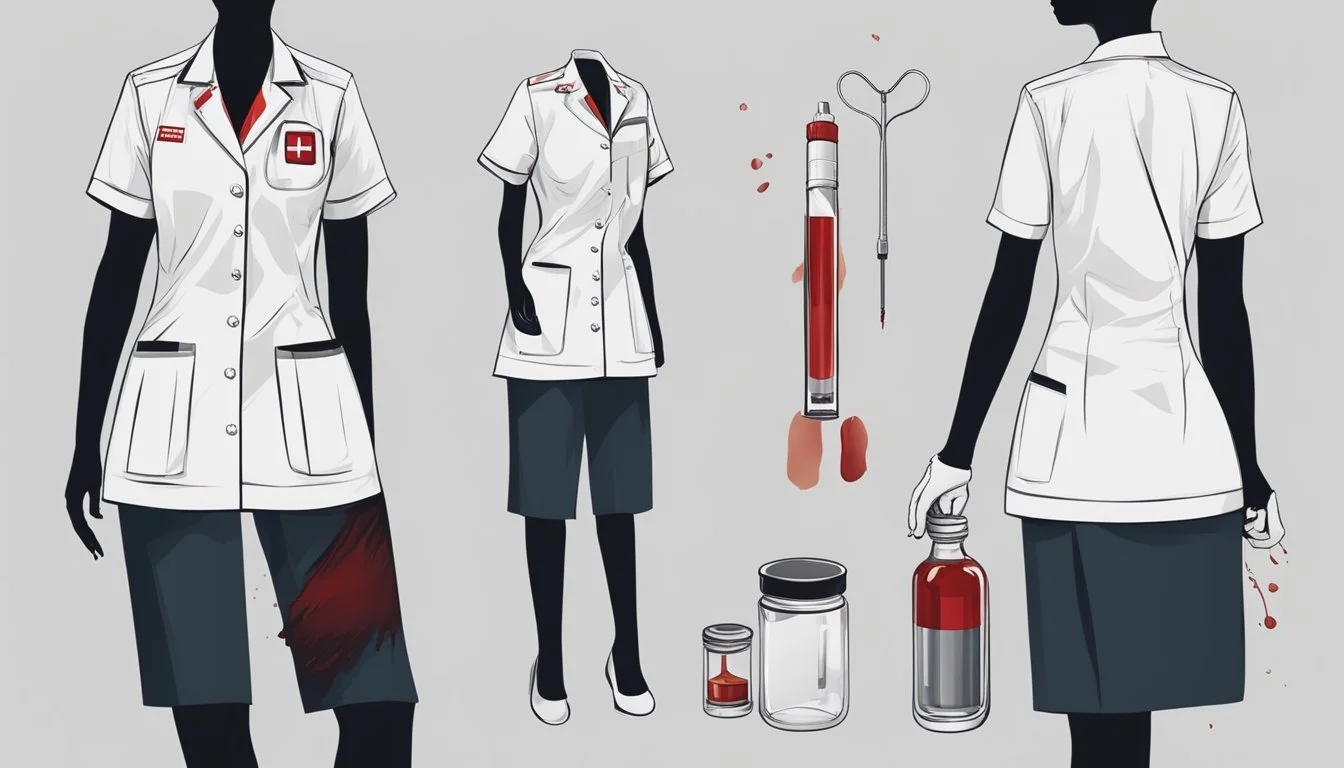Dana Sue Gray: 3 Shocking Documentaries on the Thrill Killer Nurse
Unmasking a Healthcare Serial Killer
Dana Sue Gray's chilling story has captivated true crime enthusiasts for decades. As one of the few known female serial killers, her case stands out for its unusual combination of violence and compulsive shopping sprees.
Three documentaries explore Gray's crimes, shedding light on the mind of a killer who targeted elderly women for both their lives and their credit cards. These films delve into the psychology behind her actions, the investigation that led to her capture, and the impact her crimes had on the community.
1) "Interview with a Killer" by True Crime Central
"Interview with a Killer" is a documentary produced by True Crime Central that explores the disturbing case of Bianca Devins' murder. The film features an in-depth interview with Brandon Clark, the man responsible for the tragic killing of the 17-year-old in 2019.
The documentary takes viewers to Attica Prison in New York State, where journalist Yinka Bokinni conducts a face-to-face interview with Clark. This marks the first time he has spoken to the media about the crime.
Through this intense conversation, the film aims to uncover the motives behind Clark's actions and his decision to livestream the murder online. It delves into the psychological aspects of the killer and the impact of social media on violent crimes.
"Interview with a Killer" also explores the aftermath of the murder, including the viral spread of images from the crime scene. The documentary raises important questions about internet culture and the ethical implications of sharing graphic content online.
By presenting this raw and unfiltered account, True Crime Central offers viewers a chilling glimpse into the mind of a killer and the devastating consequences of his actions.
2) "Dark Angel: The Dana Sue Gray Story" on Netflix
"Dark Angel: The Dana Sue Gray Story" is a gripping documentary available on Netflix. The film explores the chilling crimes of Dana Sue Gray, a former nurse turned serial killer.
Directed by award-winning filmmaker Sarah Smith, this documentary delves into Gray's background and motivations. It features interviews with investigators, survivors, and forensic experts who worked on the case.
The film meticulously reconstructs Gray's killing spree in California during the 1990s. It examines how she targeted elderly women, gaining their trust before robbing and murdering them.
"Dark Angel" also analyzes the psychological aspects of Gray's crimes. Experts discuss her thrill-seeking behavior and the role her nursing background played in her ability to evade detection.
The documentary includes rare footage from Gray's trial and sentencing. It presents a balanced view of the case, exploring both the prosecution's arguments and the defense's claims.
Viewers gain insight into the impact of Gray's actions on the victims' families and the community. The film also touches on the broader implications for healthcare and elderly care systems.
https://www.imdb.com/title/tt13893456/
3) "Nurse Gone Wrong": A Deep Dive Documentary
"Nurse Gone Wrong" offers an in-depth examination of Dana Sue Gray's life and crimes. The documentary explores Gray's background as a licensed vocational nurse and her descent into serial killing.
The film features interviews with law enforcement officials who worked on the case. It also includes insights from forensic psychologists who analyze Gray's motives and behavior patterns.
"Nurse Gone Wrong" delves into Gray's modus operandi, focusing on her targeting of elderly women. The documentary highlights how Gray used her nursing credentials to gain trust and access to her victims' homes.
The filmmakers present a detailed timeline of Gray's crime spree, which took place in 1994. They examine each of her attacks, including the three murders and one attempted murder she committed.
The documentary also explores Gray's shopping addiction and how it factored into her crimes. It discusses her habit of using her victims' credit cards to make expensive purchases after killing them.
"Nurse Gone Wrong" provides a comprehensive look at Gray's arrest, trial, and subsequent conviction. The film concludes with a discussion of Gray's current status in prison and the lasting impact of her crimes.
https://www.imdb.com/title/tt26673151/
Background of Dana Sue Gray
Dana Sue Gray's troubled past and career as a nurse preceded her descent into violent crime. Her early life experiences and professional background provide context for understanding the events that led to her criminal acts.
Early Life and Career
Dana Sue Armbrust was born on December 6, 1957, in California. Her parents were Russell Armbrust, a hairdresser, and Beverly Joyce Hetzel, a former beauty queen and MGM starlet. Dana grew up as an only child after her mother experienced several miscarriages.
Gray pursued a career in nursing, obtaining her license and working in various healthcare settings. Her professional background in patient care would later contrast sharply with her criminal actions.
Events Leading to the Crimes
In the 1990s, Gray faced personal and financial difficulties that seemed to trigger her criminal behavior. She developed a shopping addiction and accumulated significant debt.
This financial strain, combined with possible underlying psychological issues, appeared to motivate her targeting of elderly women for robbery and murder. Gray's crimes began in February 1994 and continued until her arrest in March of that year.
Her attacks focused on older women living alone, whom she saw as vulnerable targets for theft and violence. Gray's nursing background may have influenced her victim selection and approach.
Criminal Profile
Dana Sue Gray's case provides insight into the mind and methods of a rare female serial killer. Her psychological profile and crime patterns reveal a complex mix of motivations and behaviors.
Psychological Analysis
Gray exhibited traits associated with antisocial personality disorder and narcissism. She lacked empathy for her victims and showed no remorse for her crimes. Psychiatrists noted her manipulative nature and inability to form genuine emotional connections.
Gray's troubled childhood likely contributed to her psychological issues. Her mother's emotional instability and father's absence created an unstable home environment. This may have impacted Gray's ability to regulate emotions and form healthy relationships as an adult.
Despite her mental health struggles, Gray was deemed legally sane at the time of her crimes. She understood the nature of her actions but chose to commit them anyway.
Methods and Motives
Gray targeted elderly women, viewing them as easy prey. She gained entry to their homes by posing as a nurse or salesperson. Once inside, she would strangle or bludgeon her victims before robbing them.
Financial gain was a primary motive, as Gray used stolen credit cards to fund shopping sprees. However, she also admitted to experiencing a "thrill" from the killings. This combination of practical and psychological motives is uncommon in female serial killers.
Gray's nursing background gave her knowledge of human anatomy, which she used in her attacks. She carefully selected vulnerable targets and planned her crimes to minimize the risk of capture.
Impact of Dana Sue Gray's Crimes
Dana Sue Gray's murderous spree sent shockwaves through California communities and drew national attention. Her case highlighted vulnerabilities of elderly women and raised questions about healthcare worker screening.
Media Coverage
Gray's crimes attracted significant media interest due to their brutal nature and her status as a female serial killer. Local and national news outlets extensively covered the investigations and trial. True crime shows like "Deadly Women" and "Snapped" featured episodes on Gray, analyzing her motivations and methods.
Several books examined her case in detail, including "Disturbed" by Nancy Whitfield. The media portrayals often emphasized Gray's shopping sprees with victims' credit cards, painting her as a materialistic killer. Some coverage explored her troubled childhood and nursing career for insights into her psychology.
Public Reaction
Gray's murders sparked fear among elderly residents in Canyon Lake and surrounding areas. Many seniors upgraded home security systems and became wary of strangers. Community watch programs expanded in the wake of her crimes.
The case prompted discussions about elder abuse and protections for vulnerable populations. Some advocated for stricter background checks on healthcare workers with access to elderly patients. Gray's actions damaged public trust in home health aides and nurses.
Her relatively lenient life sentence, avoiding the death penalty, drew criticism from victims' families and some community members. Others viewed it as appropriate given her eventual guilty plea and cooperation with authorities.



